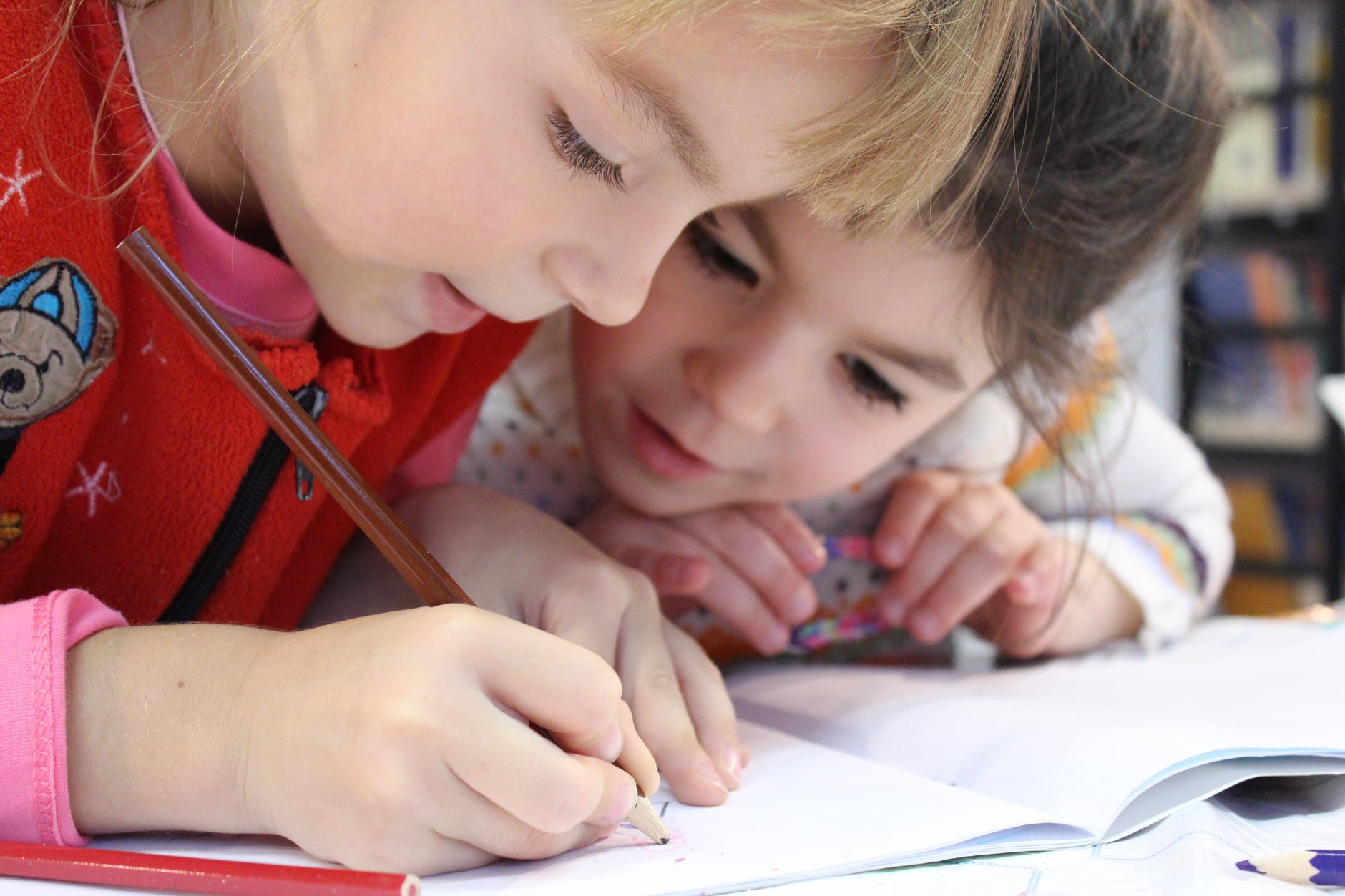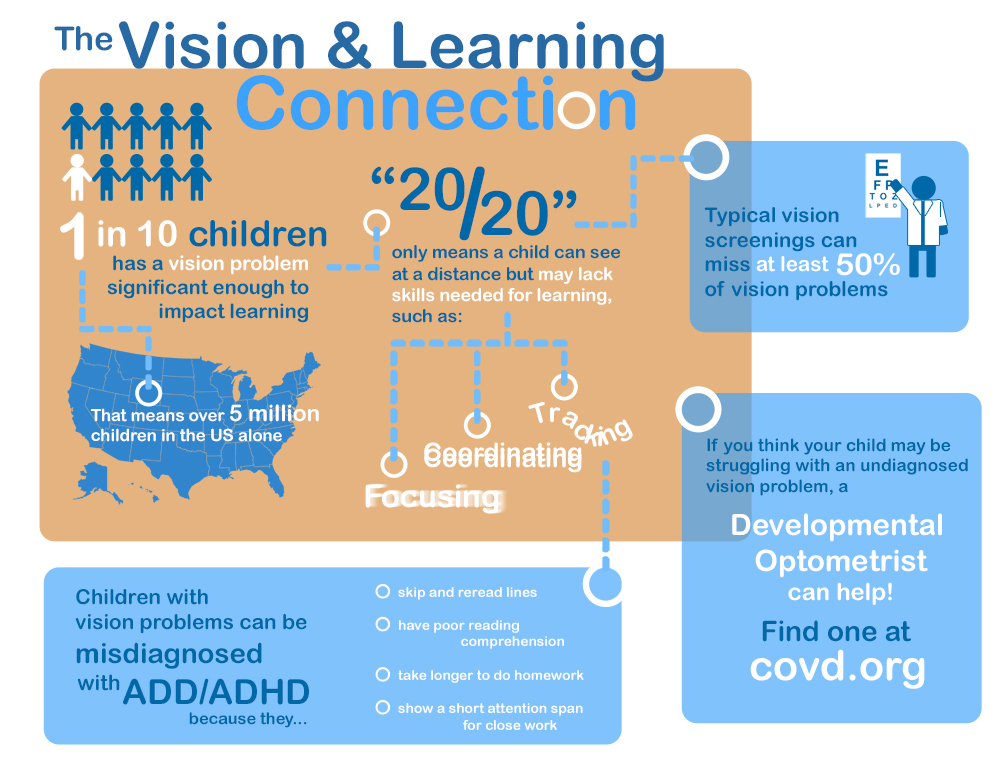Five million children in the US have vision problems that can impact learning and cause poor reading
50% of vision problems are missed in screenings according to the College of Optometrists in Vision Development
One in five preschool children have vision problems according to the American Optometric Association
Convergence Insufficiency is a common vision disorder estimated to occur in 8-12% of the population. People with convergence insufficiency can pass a vision screening easily, yet often struggle with reading due to difficulty focusing. In fact, according to research 33% of children diagnosed with attention deficit disorder have convergence insufficiency.
50% of the brain is comprised of visual pathways
80% of learning in a classroom is accomplished through vision
Vision Therapy is an effective treatment for many visual processing deficits. Vision therapy is similar to how physical therapy, speech therapy and occupational therapy are delivered and involved individualized treatment plans to aid in the development or rehabilitation of the visual system.
Not all learning problems are due to vision problems, but with these eye-opening statistics it should not be a surprise that many children are suffering with undiagnosed vision problems that are interfering with their potential. Poor visual skills, such as convergence insufficiency, can impact reading and difficulty with reading can make school quite miserable. That’s why we believe in the importance of a complete visual processing evaluation for any struggling student!

Perfect eyesight does not equal perfect vision! Even if your child has had an eye examination, they may have a vision problem that is contributing to their struggles. Here are a few key questions that indicate a vision problem is present.
- Does my child perform better with larger print?
- If bigger print is easier the only difference is the visual presentation. If your child reads/performs better with bigger print relative to smaller print there is a high likelihood vision is interfering.
- Does my child perform better listening rather than reading?
- If attention and/or comprehension are improved when bypassing the visual system then there is a high likelihood that vision is interfering. For obvious reasons, poor reading due to a vision disorder will make a child more keen on listening.
- Did my child perform well in the early grades and is struggling more as they get older?
- Early education involves pictures and individual letters at generous sizes. As reading instruction commences there are less pictures and smaller text on the page. That puts a premium on visual processing and intelligent children can start to struggle because vision is interfering. A common diagnosis in a school age child is convergence insufficiency.
Is your child struggling in school? Contact us today and let our experts in vision and learning possibly help unlock your child’s potential! We have been able to help kids dramatically improve their school experience as they overcome their difficulty with reading and other struggles. Quality vision therapy has the potential to make all of the difference.
Learn more at the dedicated site for information on vision and learning from the Vision Help Group.
What is Vision Therapy?
Vision therapy is a doctor driven, individualized treatment that improves how the brain is processing vision. Vision therapy helps people teach their visual system how to function properly without surgery or other invasive means. We use personalized approaches to help children, adolescents and adults overcome a wide range of visual disorders.
At Park Ridge Vision we believe in the key relationship between the brain and the eyes. Many times the eyes get blamed for issues that are actually rooted in behavior that comes from the brain. Vision therapy teaches the brain and the visual system how to work together so that a person can function more closely to their potential.
Similar to how physical therapy encourages health in the joints and muscles, vision therapy encourages the health in the visual system. Improved coordination, convergence and tracking in the eyes can make all the difference in someone’s ability to have good vision. Our day-to-day activities require a lot from our eyes and vision than most realize especially during activities such as reading and sports and we are referring to vision way beyond just seeing 20/20!
What is 20/20 vision?
20/20 vision is referring to the ability to see a small letter on a chart 20 feet away. The top number is referring to the testing distance and the bottom number is referring to the size of the letter. One way to understand visual acuity measures is that the bottom number is how far back someone with normal eyesight would stand to see the same size letter. If you are 20/40 than someone with normal eyesight can stand at 40 feet to see the same size letter that you can see at 20 feet. How much do you think seeing a small letter 20 feet away has to do with reading and learning? You’re correct, the answer is very little! That is why it is misguided to believe that if your child can see 20/20 that they have perfect “vision”. 20/20 may equate to perfect eyesight but it does not answer the many questions that need to be answered to determine if someone has perfect vision.
That’s why vision therapy can be so incredibly beneficial for those who struggle with certain disorders that have little to do with seeing 20/20.
Successful vision therapy is a lot more than a set of techniques and tools. It utilizes the therapeutic process to reteach the brain how to work in tandem with the eyes. Our loving therapists and doctors are experts at walking alongside patients in their individual journeys and helping them develop healthy habits. We see people’s lives change for the better on a regular basis, and we love what we do which is why it isn’t considered work at Park Ridge Vision!


